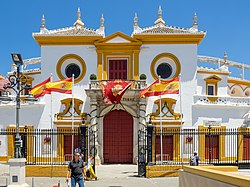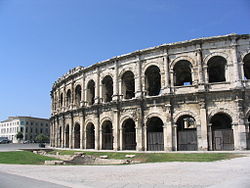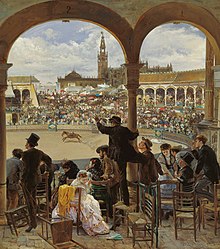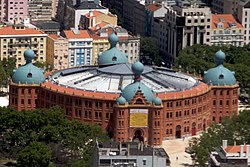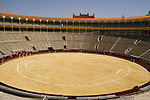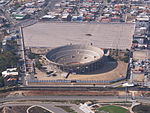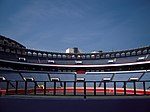
The Plaza de Toros de Las Ventas, known simply as Las Ventas, is the largest bullfighting ring in Spain, located in the Guindalera quarter of the Salamanca district of Madrid. It was inaugurated on June 17, 1931. Its seating capacity of 23,798, makes it the third-largest bullfighting run in the world, after bullrings in Mexico and Venezuela. After the federal ban of bulfighting in Plaza México, Las Ventas is the second largest bullring in the world still in operation for its original intention.

The Plaza de Toros de Ronda is a Bullring in Ronda, it has a diameter of 66 metres (217 ft), surrounded by a passage formed by two rings of stone. There are two layers of seating, each with five raised rows and 136 pillars that make up 68 arches. The Royal Box has a sloping roof covered in Arabic tiles. The design of the main entrance to the bull ring features two Tuscan columns and the royal shield of Spain surround by baroque edging. The main door is large enough to allow horses and carriages to enter the ring, and above the door is an iron wrought balcony that embodies the bullfighting culture.

Francisco Rivera Pérez, better known as Paquirri, was a Spanish bullfighter. He died after being gored by a bull named Avispado at the Pozoblanco bullring. During his career, he was six times borne shoulder-high out through the Great Gate at Las Ventas.

The plaza de toros de la Real Maestranza de Caballería de Sevilla is a 12,000-capacity bullring in Seville, Spain. During the annual Seville Fair in Seville, it is the site of one of the most well-known bullfighting festivals in the world. It is a part of the Real Maestranza de Caballería de Sevilla, a noble guild established for traditional cavalry training.

The Plaza de Torosde Acho is the premier bullring in Lima, Peru. Located beside the historical center of the Rímac District, the plaza is classified as a national historic monument. It is the oldest bullring in the Americas and the second-oldest in the world after La Maestranza in Spain. It opened on 30 January 1766.

The Spanish Fighting Bull is an Iberian heterogeneous cattle population. It is exclusively bred free-range on extensive estates in Spain, Portugal, France and Latin American countries where bullfighting is organized. Fighting bulls are selected primarily for a certain combination of aggression, energy, strength and stamina. In order to preserve their natural traits, during breeding the bulls rarely encounter humans, and if so, never encounter them on foot.
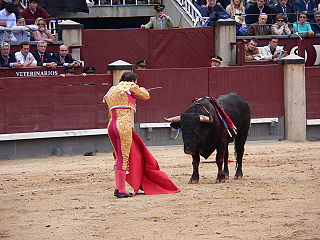
Bullfighting is a physical contest that involves a bullfighter attempting to subdue, immobilize, or kill a bull, usually according to a set of rules, guidelines, or cultural expectations.

Feria del Sol, or Carnaval Taurino de América, is an international cultural festival held in the city of Mérida, Venezuela every year in February. The Feria festival is held alongside the carnival feast. The festival includes bull competitions, cultural expositions, commercial and zootechnic expositions, concerts, parades, sports, and a voting competition for La Reina Del Sol.
Bullfighting was banned in the Spanish autonomous community of Catalonia by a vote of the Catalan Parliament in July 2010. The ban came into effect on 1 January 2012. The last bullfight in the region took place on 25 September 2011 at La Monumental. The ban was officially annulled for being unconstitutional by Spain's highest court on 5 October 2016. However, despite the overturning of the ban, no further bullfight had taken place in Catalonia as of July 2020.

The Plaza de Toros Monumental de Barcelona, often known simply as La Monumental, is a bullring in the city of Barcelona, Catalonia, Spain. It was the last bullfighting arena in commercial operation in Catalonia. It was inaugurated in 1914 under the name Plaza de El Sport and was soon expanded and given its current name in 1916. It is situated at the confluence of the Gran Via and Carrer Marina in the Eixample district. It has a capacity of 19,582 within 26 rows of lines, boxes, and stands on the first floor inside and an upper gallery surrounding the building.

The Plaza de Toros de La Merced is a bullring in the Andalusian city of Huelva, Spain. The current building, which was reinaugurated in 1984 after being rehabilitated by architect Luis Marquínez, is an updated version of an old bullring, built in the years 1899 to 1902 and designed by architect Trinidad Gallego y Díaz. For years, it stood empty as bullfights were instead held at another, newer bullring that eventually had to fall to the wrecker's ball when it turned out to be unsafe. In its more than one hundred years of existence, the Merced bullring has borne witness to not only authentic glory in the Bull Festival, but also to the bullfighting figures from all eras who have filed through it. The rehabilitated bullring's foreseen capacity was 10,000, but its actual current capacity is 7,127.
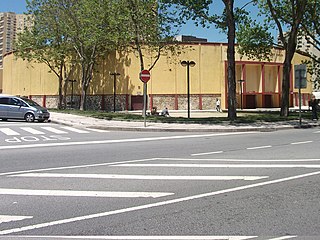
Póvoa de Varzim Bullfighting Arena was a bullring in Póvoa de Varzim, Portugal. It is located on Avenida Vasco da Gama, on the northern waterfront of the city. Bullfighting, horse shows, and concerts are held in the arena.
Miguel Báez Espuny, better known as "El Litri", was a Spanish bullfighter, a descendant of one of Huelva's foremost bullfighting dynasties.

Hilda Eliana Tenorio Patiño is a Mexican bullfighter and matador. She was the first woman to receive her alternativa in the Plaza de Toros México, the largest bullring in the world, aged 24. Tenorio completed her alternativa on February 28, 2010. She has been an outspoken advocate of feminism in the sport. She is the third Mexican woman to attain the rank of matador.

The Plaza de Toros de Pontevedra (Spain) is the bullring of the Spanish city of Pontevedra and the only one in the autonomous community of Galicia. It has a capacity of 7,800 spectators and is classified as the second category of Spanish bullring. The current bullring replaced a wooden one dating from 1892, although the tradition of bullfighting in Pontevedra dates back to the 17th century.

José Luis Vázquez Garcés, better known as Pepe Luis Vázquez, the same name that his son would later use professionally, was a Spanish bullfighter, considered one of 20th-century bullfighting's most significant figures.

José María Dols Samper, also known professionally as José Mari Manzanares hijo is a Spanish bullfighter and model. He has twice been borne shoulder-high out through the Great Gate at the Las Ventas bullring in Madrid.

Rafael Cerro Ginés is a Spanish bullfighter who is currently active in the world of tauromachy, albeit in a more managerial capacity nowadays.

Francisco Camino Sánchez, known in the bullfighting world as Paco Camino, was a Spanish bullfighter and bull breeder. A bullfighter of the highest order, he dominated tauromachy and was twelve times borne shoulder-high out through the Great Gate at Las Ventas in Madrid, a record bested only by Santiago Martín Sánchez.
Jesús Martínez Barrios, known as Morenito de Aranda is a Spanish bullfighter. Born in a small town in Burgos, he had no family background in bullfighting, but has nonetheless become a well known matador in his own country and abroad. His interests also extend to raising the very cattle that he fights at a farm that he established.

